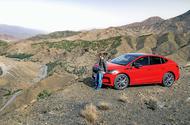How challenging will it be to introduce EVs everywhere?
Autocar’s James Attwood takes a 4×4 Skoda Enyaq to the desert with a glovebox full of range anxiety pills
Ouarzazate is known as the gateway to the Sahara – and the driveway to that gate is Morocco’s N9 highway. The road winds from Marrakesh through the High Atlas mountains, where barren, sun-parched, rocky landscapes meet snow-covered peaks.
At the dizzying Tizi n’Tichka pass, it practically folds in on itself. Just 200 miles south-west from here is the vast nothingness of the Sahara desert. And that’s where I’ve just come from – driving a Skoda Enyaq Coupé 85x.
The challenge was to find out how an electric car coped in a desert climate, but also to consider a wider question: if electric cars are the future, how challenging will it be to introduce them everywhere?
After all, when buyers are put off EVs because the north of England is considered a ‘charging desert’, can electric cars ever work in a real one?
![]()
Here comes the sun
The answer to that question is obvious, of course. Just look up, either at the sun or, if you’re near where I am today, the glowing, 250-metre-high tower of the Noor Ouarzazate Solar Complex.
The Drâa-Tafilalet region averages nearly 3500 hours of sunshine per year, and with much of the land desolate and unoccupied, it’s an ideal place to harness solar power on a vast scale.
The Noor complex covers 3000 hectares – about 3500 football pitches – and, depending on your taste in movies, looks like a Bond villain’s lair or an otherworldly alien edifice dropped into the desert.
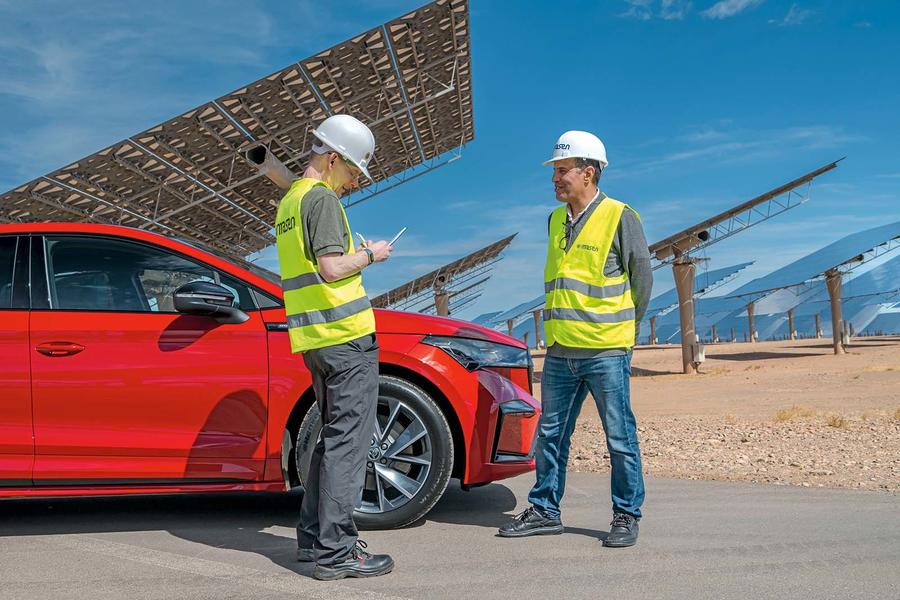
Noor’s four different plants have a combined rated capacity of 582MW. That’s about half the output of a nuclear power station and enough to power two million Moroccan homes each year. It’s key to helping to reduce the North African country’s dependence on imported energy.
It’s also the ideal place to start this drive, not least because it feels well equipped to charge an Enyaq Coupé: Noor’s daily output of around 5GW is enough to charge more than 60,000 82kWh batteries.
Except Noor doesn’t have a fast charger, so I’m reduced to a domestic plug socket in a bench in the car park. Luckily, the Enyaq was nearly full when I got here.
The road to the Sahara
From Noor, our next stop is the edge of the Sahara, 175 miles south of here. Range anxiety shouldn’t be an issue, given this dual-motor model’s range of 332 miles, although the prospect of running out of juice in a desert looms large.
Our route from Noor takes us through the centre of Ouarzazate. Its name is taken from a Berber word meaning ‘without noise’, and what can be more apt than gliding through in a silent EV? The Enyaq’s excellent noise isolation and quiet interior make for a surreal contrast to the chaotic bustle on the packed streets.
Escaping the town means a chance to enjoy the effortless performance of the Skoda. I spent time last year running the 335bhp vRS version, but this £50,250 85x feels the better option: 282bhp is still plenty, but it’s a bit softer and more relaxed. While I prefer the cheaper, 353-mile single-motor version, I suspect the four-wheel drive would be useful in the desert.
This car is in entry-level Sportline Plus trim, but it’s still really well equipped. Spacious, too.
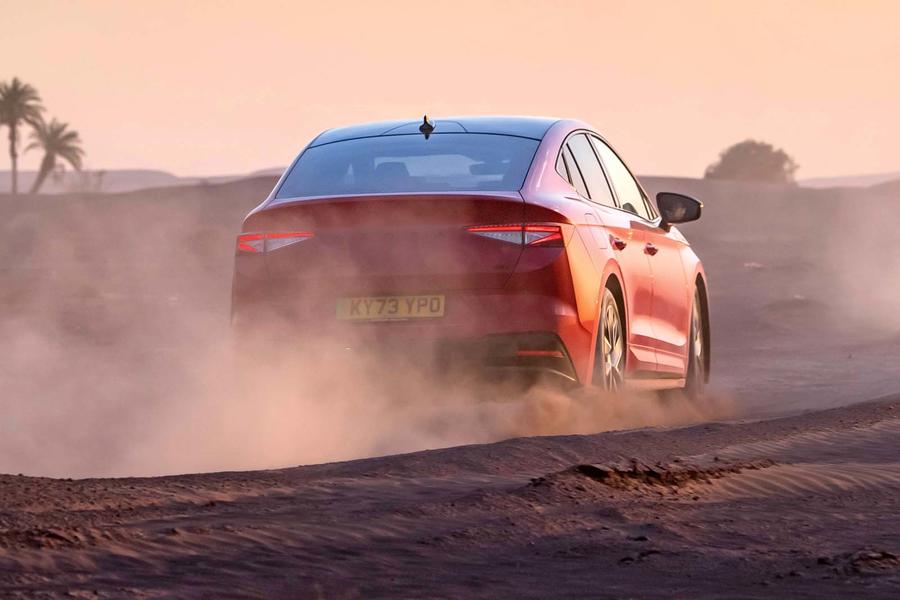
This is Skoda doing what it has done so well in recent years: taking a Volkswagen Group platform (MEB in this case) and producing a model mixing acres of space, practicality and a bit of class. It certainly has a better-resolved interior than Volkswagen’s initial MEB offerings.
It rides well here, too. That said, the Moroccan roads help: the N9 highway is superb and for the most part significantly smoother than anything you would find in the UK. Traffic is sparse and the Enyaq makes short work of overtaking slow-moving trucks and ageing cars.
I make one stop heading south, at Kasbah Sirocco in the small town of Zagora. It’s a chance to fill up on baklava and electricity, as the hotel has a 7kW charger. That said, I barely need the electrons: having travelled 115 miles, there’s plenty left in the Enyaq Coupé’s battery.
The near-30deg C heat and smooth roads are great news for efficiency: on one leg I achieve 4.5mpkWh, surpassing the Enyaq’s official economy of 3.9mpkWh. No heat pumps needed here.
Besides, it’s late afternoon and I’m keen to reach the Sahara before dark. We’re staying in a desert camp and I’m not sure the street lighting there will be up to much. For the next 100 miles, the road becomes ever more flowing, the towns more spread out. On the outskirts of M’Hamid, where the N9 ends, a local garage’s forecourt is filled with broken and crashed 4x4s.
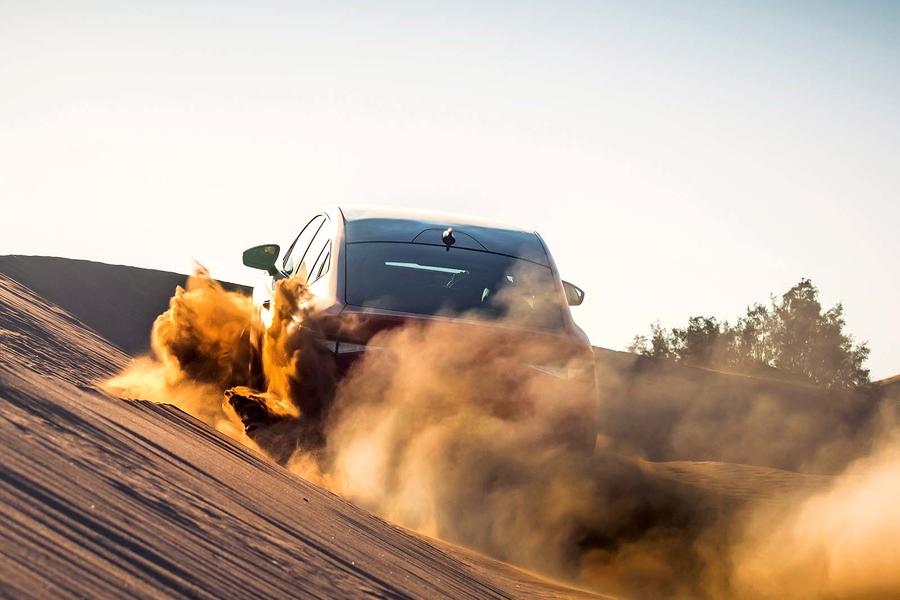
I suspect its mechanics have never encountered an EV, so I’m cautious when I turn onto the desert track that leads to the camp. Still, the Enyaq has four-wheel drive and it would be a shame not to use it. And while it’s absolutely not a dedicated off-roader, it copes with the loose gravel and shifting sand with ease.
With the sun low in the sky and the temperature dropping faster than the charge in the Enyaq Coupé, I reach camp. It’s not as basic as it sounds: my tent has a proper bed, toilet and electricity. Although, given that the power cuts out enough to make charging a laptop challenging, you realise the infrastructure is some way from being able to cope with EVs.
Our berber hosts serve up a tajine, supplemented by bread baked in the embers of the campfire. It’s an ancient tradition, although they use their phone flashlights to check if the bread is cooked. Modern tech benefiting an ancient lifestyle? There’s an EV metaphor in there somewhere. But it has been a long day and I want to get up early for the desert sunrise.
No EV charging beyond this point
The early start is worth it, both for the spectacular sunrise and the appearance of a train of camels brought by the berbers. Camels are famously efficient: they can consume hundreds of litres of water in minutes, then go more than a week without drinking. Fast charging and incredible efficiency? There’s another aspirational EV metaphor in there somewhere.
I reached the Sahara with just under 50% charge left, but this isn’t a place to push it. And why do that when I can visit the Sbai Palace n M’Hamid? It has a pool, excellent Moroccan tea, free wi-fi – and a pair of 22kW EV chargers.
Full disclosure: the chargers are here because of Skoda UK, which installed them at the desert hotel to make this trip easier. But credit to the hotel’s owner for agreeing, anticipating that they might boost his Tripadvisor score in future.
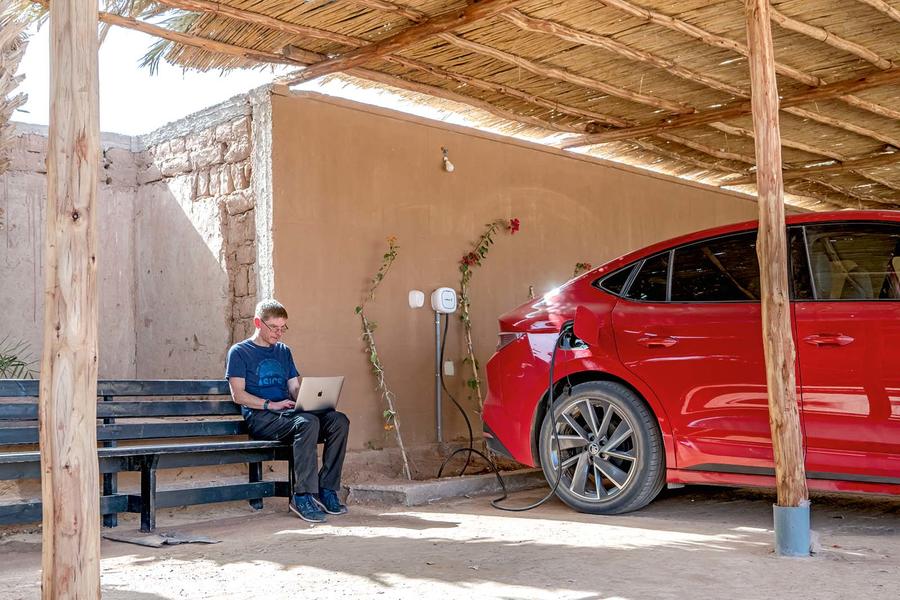
While plugged in, I check out my next charging options. They’re… limited. Head south and the next charger is 1600 miles away in Accra, Ghana. Head south-east and it’s 3000 miles away in Kampala, Uganda. Unlikely I’d make either in the Enyaq.
Mind you, 20 miles south and I’d be in Algeria, where safety would be more of a concern than the battery. And it’s not like the Sahara is flush with petrol stations, either. Better to return to Ouarzazate. No hardship: it’s a fabulous road.
The Enyaq has that wonderful Skoda quality of being smart without being showy, and even here few people seem to begrudge the British-plated EV. It’s also quite a contrast to the many ageing cars still in heavy use: Peugeot 205s and Renault 4s and 19s are common sights. It’s another form of sustainability: I’d love to see an expert conduct a life-cycle emissions analysis on one of them.
There’s a particularly glorious 4 parked at a mountain overlook: it serves as a souvenir shop and is in fine condition. I’m briefly tempted when the owner offers to trade it for the Enyaq.
Having haggled for a scarf, I’m about to leave when something catches my eye on the horizon: a bright, unnatural, alien light. It’s the Noor IV tower, glowing brilliantly despite being more than 30 miles away.
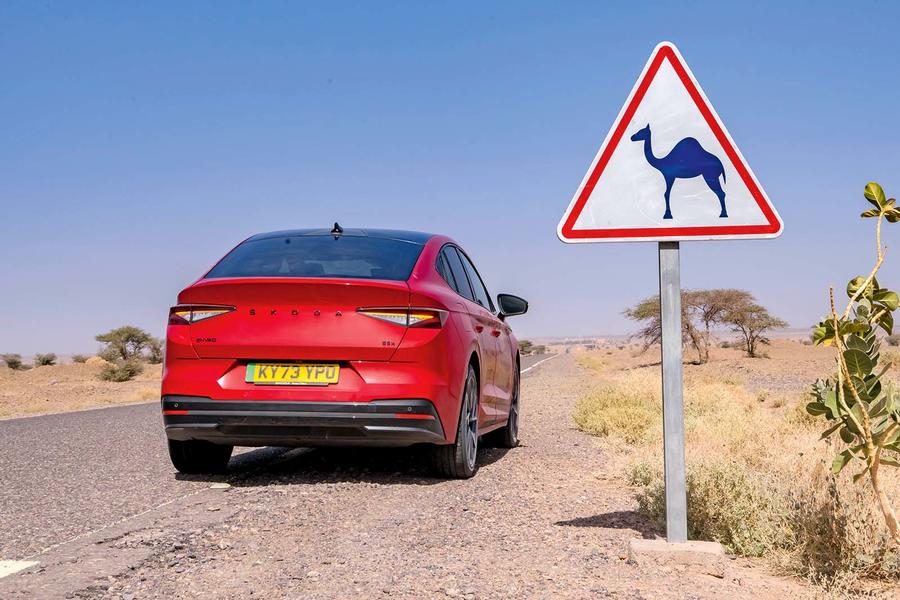
Out of the Sahara
Ouarzazate is an odd town: our hotel is full of tourists on a coach tour and people working at the nearby film studios. Scenes from Lawrence of Arabia, Gladiator, The Living Daylights and more were filmed here. And in a garage opposite the studios is a pair of EV chargers.
They’re not super-fast, but they work, and predictably there isn’t a queue. Between Marrakesh and the Sahara, there are just five chargers in three locations on the N9, but none are busy. You don’t need masses of infrastructure when there aren’t masses of EVs.
With just 120 miles to Marrakesh, there’s time for a detour, so I turn off the N9 on a small single-lane road that leads to Telouet, following a river valley. At one stage a charging Citroën Berlingo fills my mirrors, so I let it past. The driver speeds off with the confidence that comes from immense local knowledge.
Yet a few miles later, on a series of sharp uphill switchbacks, I’m right on his tail. The electric Skoda makes short work of the slopes while the Berlingo is reduced to a crawl, belching diesel as it goes. EVs are well suited to this terrain.
Many of the houses in the villages that dot the road are topped with photovoltaic solar panels. In an area where the infrastructure is lacking, having your own power source is a boon. So imagine the benefit of an EV that could serve as transport and an energy store.
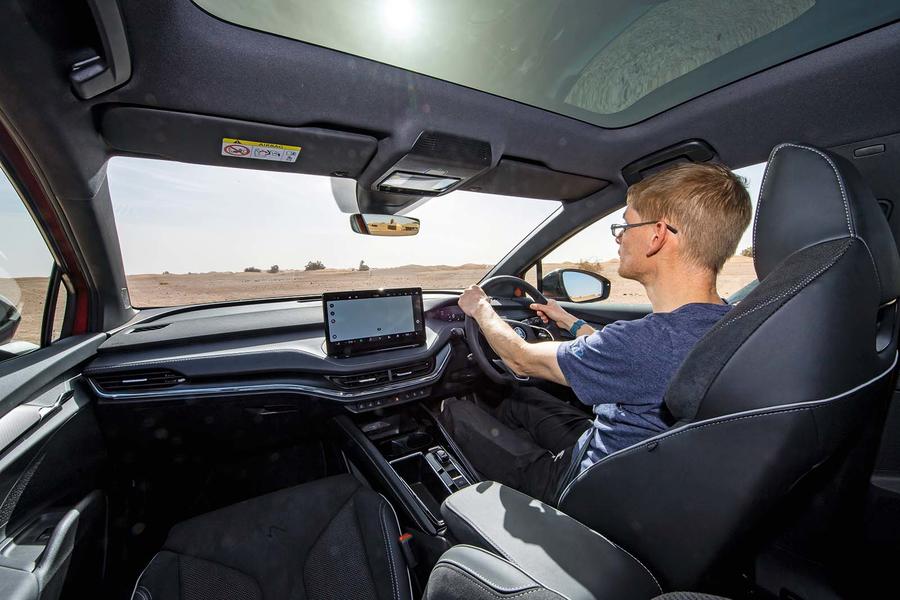
But there’s another common sight: blue tents. This region was hit by a massive earthquake last year, and some families are still living in emergency shelters. In other towns, the recovery efforts seemingly stretch as far as leaving piles of bricks on the side of the road. It’s a sobering sight from the air-conditioned comfort of the Skoda.
The road emerges at Telouet, a tourist draw for its imposing kasbah that has a gloriously restored interior. Well, apparently. It was damaged in the earthquake and shut for safety reasons. Officials say there’s no money to repair it, to the chagrin of local traders whose businesses have been hit by the resulting lack of tourists.
It creates a conundrum that I’m still thinking about as I reach the Tizi n’Tichka pass. The goal was to drive an electric car to the Sahara desert and see how it fared. The answer is superbly: the Enyaq Coupé coped admirably in a wide range of challenging conditions and was never less than agreeable.
But there’s also that bigger question: can electric cars work here? There’s huge potential, given all that lovely solar power. But it will require considerable investment to develop both that and a reliable EV infrastructure. And when money can’t be found to repair historic sites or people’s homes, you question the wisdom of investing in EVs, given how few Moroccans could afford one.
So the cars are too expensive and the infrastructure is lacking. Sounds familiar, doesn’t it? But when the cars and the infrastructure become cheaper, as they surely must, electric cars really could work here. That’s a long time in the future, though. Until then, if you’re heading to the Sahara in an EV, I strongly recommend the Sbai Palace…
Source: Autocar
